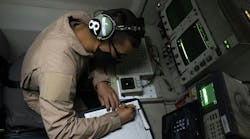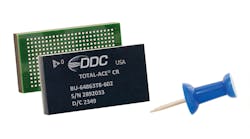- NAME: Andrew “Andy” Dunn
- TITLE: VP, Business Development, Integrated & Electronic Warfare
- CO.: Exelis Inc., Electronic Systems Division
- ROLE: Overseeing electronic warfare business area
- CONTACT: www.exelisinc.com
An Exelis executive discusses the importance and increased investment in airborne electronic warfare (EW) technologies worldwide.
What is prompting increased investment in EW?
The biggest change in the world is the much abused words Pivot to the Pacific and reacting to the anti-access/area-denial (A2AD) strategies. EW demands in the past were to support ongoing conflicts in Iraq and Afghanistan, so the focus of those EW investments were counter-IED, for example, and other technologies to fight that war and counter the threats of those campaigns. As we are now out of Iraq and winding down in Afghanistan and looking to a different part of the world, Asia-Pacific, the entire threat scenario is radically changed so there’s significant investment to address the new environment that we and our allies will be seeing in this new area of operations. That’s one of the focuses on EW, the threat scenario has changed dramatically.
As the Department of Defense (DOD) talks about a lot of the hard problems that the U.S. and its allies are facing, EW certainly has a significant role in solving those problems. Whether it is protecting a carrier strike force or doing a deep strike into a potential adversary’s area of control, EW is an important part of it.
The whole mindset of the U.S. has changed. We have had unfettered access to the areas in which we operated in the past. When we went to send up unmanned aircraft systems (UAS), we essentially had free reign in both the electromagnetic and physical spectrums. We were able to fly where we wanted to, get to where we needed to be, and had access to areas in which we were operating. That has all changed now. We may not have that access in the future, and we may not be in uncontested battle spaces—the electromagnetic spectrum, physical battlespace, etc. That’s the whole concept of the anti-access/area-denial. It’s a whole different mindset, and different scenarios future warfighters will be seeing.
The other is the air-sea battle. In the old days, even prior to the Iraq and Afghanistan wars, the concept was air-land battle. The geographic area, the battlefield, has changed significantly. Now we’re going from the air-land battle to the air-sea battle so the focus on the Air Force and the Navy, their ability to get into where they need to be, and having unfettered access once they get there.
Are other regions investing in EW?
Our allies are investing in EW. Australia has invested heavily in standoff jamming technologies, the F-18G Growler. It’s not only the U.S., the Aussies have purchased 24 Super Hornets and are preparing a significant number of Growlers that are very focused on A2AD and air-sea battles. So allies are aware of what is going on. All the challenges associated with the contested sea lanes [such as around the Spratly Islands in the South China Sea] have caused a lot of concern among our allies in that area and they’re increasing their investments in capabilities to address the geopolitical realities that are appearing in the region. A very tangible one is Australia’s procurement of the Growler.
How are you winning contract awards (opposed to competitors)?
We pride ourselves for being closer to customers than competitors. Customer intimacy is part of our portfolio and part of our success, making sure that we have products that the customers are looking for, anticipating their hard problems, and investing in those technologies that are going to support/help them with their hard problems.
We knew that the Joint Strike Fighter (JSF) was coming – and it is one of the most beautifully cancel-proof programs ever made, with so many countries involved that the U.S. is in no way going to be able to back away from that platform because of the political ramifications. We knew that there was going to be an availability of F-16s around the world that countries are going to need to keep relevant and to acquire. The Netherlands is part of the JSF program; they have a significant number of F-16s and are selling them on the international marketplace. The U.S. Air Force has what they call excess defense articles, which are F-16s that are no longer needed by the Air Force and they are offering them to the international community, as well. One of the capability gaps in the F-16s is EW.
We invested a number of years ago to be able to provide to F-16 users an upgraded EW that could be relatively easily integrated. We were able to anticipate the need and develop the technology. It’s an example of trying to understand customer needs and investing in those technologies and capabilities that they will need. When they say they have this gap, we are able to provide the technology quickly.
Exelis won a contract from Turkey. Why?
This is an opinion of Andrew Dunn, but an interesting thing is occurring. The U.S. has said that we’re now doing the proverbial pivot, we’re now going to be less focused on south and southwest Asia (i.e., the Middle East) and looking more toward southeast Asia – a lot of countries in that area are now going what do you mean you’re not going to be here for me? Obviously they don’t say that, and we don’t say that to them either. The message is being proliferated that our focus is in the Asia-Pacific region with the pivot. So a lot of countries in the Middle East saying with that potential vacuum, we need to do something. What you are seeing are countries like Saudi Arabia spending massive amounts of money; two years ago, they had the largest LOA, which is the terminology for an FMS, procurement in history buying everything from F-15s to Apaches and Black Hawks. They are spending a humungous amount of money in defense articles as a result of the perceived, potential vacuum by the U.S. focusing more on Asia Pacific than the Middle East. Turkey is seeing that same thing; Turkey is looking at taking more of a leadership role in that particular area. Their threats are quite clear. Syria is a real clear and present danger. Iran has historically been the continuing difficulty. Turkey is looking to reassert itself as a regional power, as well as being very nervous about very unstable countries next door to them, Syria and Iran. For what that is worth, it’s the Andy Dunn opinion.
Are other regions investing heavily in airborne defense/EW technologies?
The two focuses, from a business perspective, are Asia and the Middle East. Who knows, the world is ever-changing; the challenges we are looking at in Ukraine, tomorrow the whole world could change. The investments in Europe have been flat to negative, same for South America. If you look at who is spending, it’s the Middle East and Asia-Pacific.
Do you predict continued investment in airborne EW worldwide?
Yes, most certainly. We have had a hiatus in the U.S. pathology because of the issues that the DOD was facing in Iraq and Afghanistan. That has all changed. There’s going to be a lot of investment in addressing the new realities of A2AD. I absolutely see investments in airborne electronic warfare.





